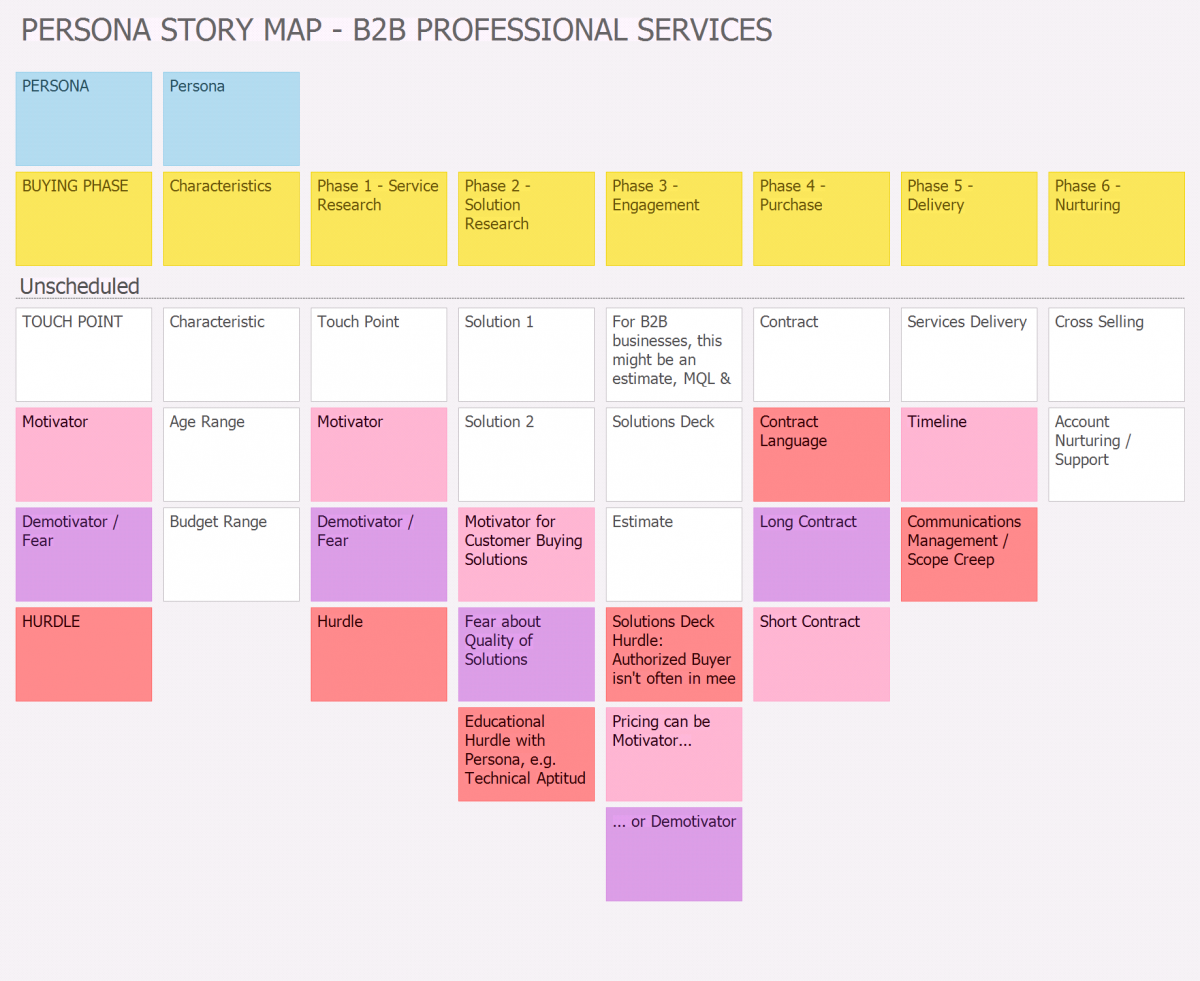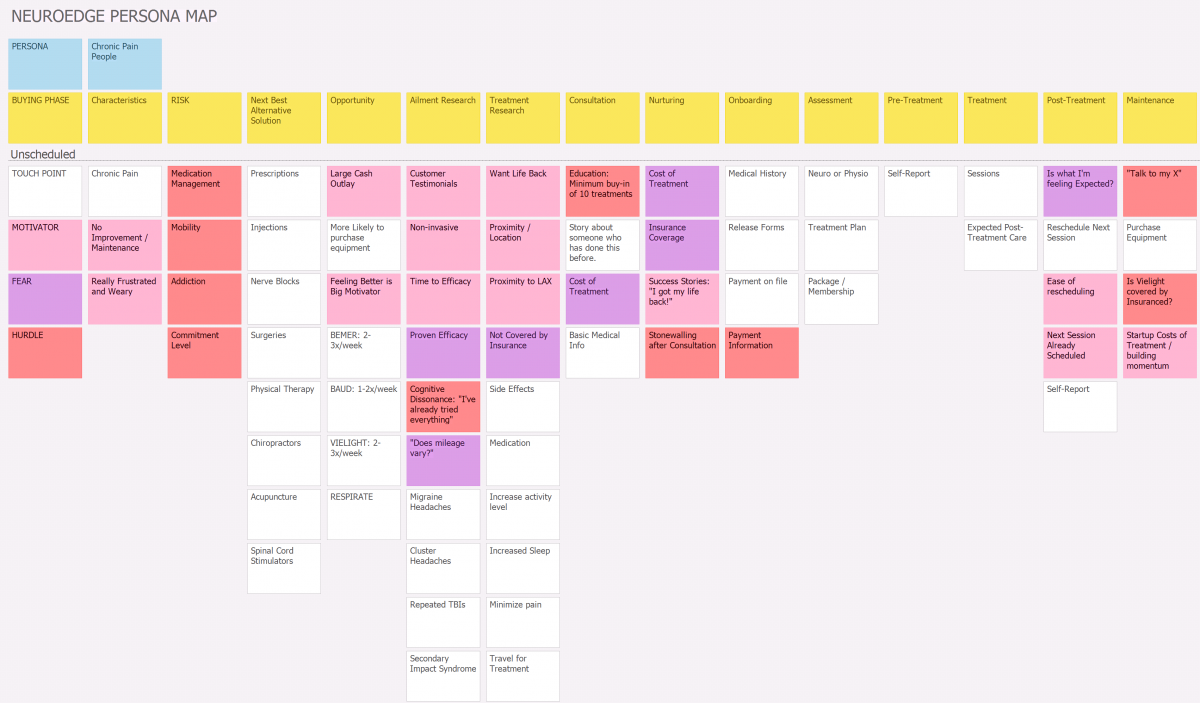Persona Story Mapping: Product Planning with Empathy
Frustrated by building and marketing products that just don’t resonate with your customers? You’re not alone. Thousands struggle to build and market products that throw the like switch on for their customers—often not realizing they are misaligned until it is too late.
Building a working model of empathy and understanding with our customers is a worthy endeavor that makes or breaks many companies the world over.
Older techniques, such as persona cards, are 1 dimensional and often dated just as soon as they are finalized. Ambiguous interpretations of dated materials can only be taken so far. In order to empower agile teams, we must take up multidimensional tools that provide an intuitive mapping of the customer’s needs through their journey.
We must build persona story maps to create a link of empathy.
Persona Story Maps
Persona story maps are two dimensional story maps that allow you to map out the touch points, motivators, fears (or demotivators), and hurdles your buyer personas face as they move through the buying process.
With a simple 2-dimensional map, stakeholders gain insight into how a buyer persona’s needs change through their customer journey. With a localized context on motivators, fears, and hurdles, we provide marketers, developers, and stakeholders an intuitive perspective to augment user story maps and content strategy.
Why is Persona Story Mapping so insightful?
While user story maps offer a single functional customer journey from beginning to end—the emotional needs of the customer are inferred, but often not included on that map.
Persona story mapping focuses on empathy. Fears, motivators, and hurdles within each phase of the customer journey give teams a new paradigm to drive discussions.
By understanding what the buyer persona cares about in each phase of the engagement, you gain a holistic view of the customer—not just a perspective on their interface (UI/UX, features developed).
Why is Persona Story Mapping so useful?
Akin to the ease-of-use user story mapping presents, persona story mapping is easy to learn and intuitive.
- Your persona makes a journey from left to right.
- The most important characteristics of a specific stage are easily prioritized top to bottom within each buying phase.
- Encapsulate parts of your application, inbound, outbound, and social media channels within the context of the needs of your customer.
- Capitalize on the emotional needs of your customers and set yourself up for success by first answering the most important question: why?
Getting Started with Persona Story Mapping is Easy
Simply educate stakeholders in your persona story mapping session about your color key for touch points, motivators, fears, and hurdles—make special note of this if you use post-its. Once stakeholders have an agreement on the buying phases, you’re off to the races adding touch points and emotional factors to the map.
Identifying stages of the buying process allows you to encapsulate many parts of your application, outbound, and social media channels within the context of customer needs. Often we forget channels, applications and features ultimately boil down to a single goal: heal their pain.
Neuroedge Center’s Chronic Pain People persona.
User goal: “Find Treatment to cure chronic pain”
Persona Story Mapping is a New Paradigm
Just as user story mapping gives you a functional view of how the customer moves through your product, the persona story map gives you an emotional view of how the customer moves through your product.
Without both, we can sometimes miss the mark accidentally marrying the wrong functional solution with emotional needs.
With this paradigm, we must answer one question:
Are we contributing to the customer’s frustration or delight?
Persona Story Mapping Benefits Marketers and Product Owners
At Facet, we use persona story maps to build our understanding of empathy around our client’s customers. Without this map, we don’t have the same working understanding of our client’s businesses, positioning, and opportunity within the marketplace.
By first building a conduit of empathy with the end-customer, we can identify opportunities for content marketing—building a content strategy around filling in the gaps in the customer journey identified in the persona story map.
With tools such as StoriesOnBoard.com or CardboardIt.com, we can treat persona story maps as a live document and iteratively update the map as we learn more about the personas. Starting your own persona story map takes about 1-2 hours per persona. Not a huge investment, in the grand scheme of things.
In this fast-paced digital world, more technologies can add more complexity, but don’t forget to take your customer’s journey back to the emotional basics with a persona story map!



